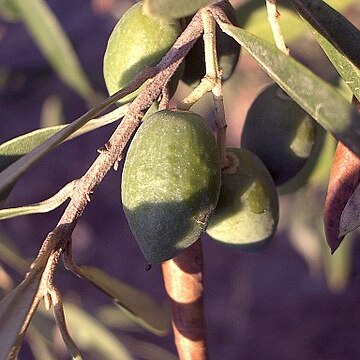Monoecious, androdioecious or dioecious trees, shrubs or climbers, evergreen or deciduous. Leaves opposite or rarely alternate (not in Australia), simple, trifoliolate or imparipinnate, entire to dentate, domatia occasionally present in abaxial nerves; stipules absent. Inflorescences axillary or terminal cymes or panicles or flowers solitary. Flowers bisexual or unisexual, actinomorphic, often heterostylous. Sepals usually small or occasionally absent (Fraxinus), 4 (–15), connate. Petals 4 (–12 in Jasminum), connate, rarely free (not in Australia), rarely absent (Fraxinus). Stamens 2, rarely 4 (not in Australia), epipetalous; anthers 2-locular, dehiscing by longitudinal slits. Ovary superior, 2-carpellate; ovules (1–) 2 (–many) per locule; placentation axile; stigma 2-lobed. Fruit a loculicidal or circumscissile capsule (not in Australia), berry, drupe, schizocarp (not in Australia) or samara. Seeds with endosperm.
Trees or shrubs, the latter sometimes trailers or scramblers. Leaves generally opposite, simple or compound, exstipulate; small depressions occupied by mites and termed acarodomatia occur on the under side of the leaves of some species. Inflorescences terminal or axillary, few-to many-flowered. Flowers hermaphrodite or rarely unisexual, regular. Calyx hypogynous, often campanulate and four-toothed. Corolla gamopetalous, rarely absent or with the segments nearly free; lobes or segments generally spreading and mostly four (except in Jasminum). Stamens usually two, epipetalous, with short filaments; no staminal disc. Ovary superior, bilocular with generally two pendulous or basal ovules in each loculus attached to the apex, side, or the base of the partition. Fruit variable, dry or fleshy, dehiscent or indehiscent. Seeds one to four per fruit; endosperm present but sometimes reduced to a thin membrane
Leaves opposite, rarely verticillate or alternate, exstipulate, simple or pinnate, sometimes with acarodomatia (small ± circular pits, often densely fringed with hairs) in axils of nerves on lower leaf–surface
Ovary superior, bicarpellate, bilocular, with 1, 2 or 4 ovules per loculus, axile, pendulous or ascending; style 1, stigma capitate or bifid
Fruit baccate or drupaceous; seeds usually with endosperm; embryo straight, the radicle sometimes hidden within the base of the cotyledons
Ovary superior, 2-celled, style simple with a capitate or bifid stigma; ovules usually 2 in each cell, axile, pendulous or ascending
Stamens hypogynous or epipetalous, usually 2; anthers apiculate, 2-celled, cells back to back, opening lengthwise
Inflorescence cymose, often paniculate (thyrsoid), sometimes fasciculate, sometimes only one flower developing
Flowers actinomorphic, hermaphrodite or rarely unisexual (not in FZ area), sometimes heterostylous
Leaves opposite or very rarely alternate, simple or pinnate; stipules absent
Petals present, free or connate, often 4, imbricate or induplicate-valvate
Flowers hermaphrodite or rarely unisexual, actinomorphic
Calyx gamosepalous, lobes 4–many (obscure in Schrebera)
Seeds sometimes winged, usually endospermous
Trees, shrubs, climbers or suffrutices
Fruit baccate, drupaceous or capsular
Corolla gamopetalous, lobes 4–many
Trees, shrubs or climbers
Stamens 2, epipetalous
Calyx lobed or dentate
Disk absent

